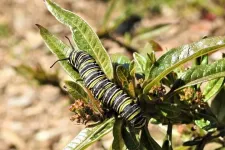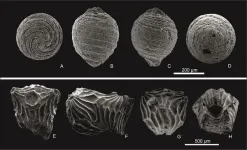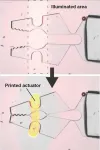A surprising discovery: Bats know the speed of sound from birth
Bats' "supersense" of time
2021-05-05
(Press-News.org) A new Tel Aviv University study has revealed, for the first time, that bats know the speed of sound from birth. In order to prove this, the researchers raised bats from the time of their birth in a helium-enriched environment in which the speed of sound is higher than normal. They found that unlike humans, who map the world in units of distance, bats map the world in units of time. What this means is that the bat perceives an insect as being at a distance of nine milliseconds, and not one and a half meters, as was thought until now.
The Study was published in PNAS.
In order to determine where things are in a space, bats use sonar - they produce sound waves that hit objects and are reflected back to the bat. Bats can estimatethe position of the object based on the time that elapses between the moment the sound wave is produced and the moment it is returned to the bat. This calculation depends on the speed of sound, which can vary in different environmental conditions, such as air composition or temperature. For example, there could be a difference of almost 10% between the speed of sound at the height of the summer, when the air is hot and the sound waves spread faster, and the winter season. Since the discovery of sonar in bats 80 years ago, researchers have been trying to figure out whether bats acquire the ability to measure the speed of sound over the course of their lifetime or are born with this innate, constant sense.
Now, researchers led by Prof. Yossi Yovel, head of the Sagol School of Neuroscience and a faculty member of the School of Zoology in the Faculty of Life Sciences and his former doctoral student Dr. Eran Amichai (currently studying at Dartmouth College) have succeeded in answering this question. The researchers conducted an experiment in which they were able to manipulate the speed of sound. They enriched the air composition with helium to increase the speed of sound, and under these conditions raised bat pups from the time of their birth, as well as adult bats. Neither the adult bats nor the bat pups were able to adjust to the new speed of sound and consistently landed in front of the target, indicating that they perceived the target as being closer - that is, they did not adjust their behavior to the higher speed of sound.
Because this occurred both in the adult bats that had learned to fly in normal environmental conditions and in the pups that learned to fly in an environment with a higher-than-normal speed of sound, the researchers concluded that the rate of the speed of sound in bats is innate - they have a constant sense of it. "Because bats need to learn to fly within a short time of their birth," explains Prof. Yovel, "we hypothesize that an evolutionary 'choice' was made to be born with this knowledge in order to save time during the sensitive development period."
Another interesting conclusion of the study is that bats do not actually calculate the distance to the target according to the speed of sound. Because they do not adjust the speed of sound encoded in their brains, it seems that they also do not translate the time it takes for the sound waves to return into units of distance. Therefore, their spatial perception is actually based on measurements of time and not distance.
Prof. Yossi Yovel: "What most excited me about this study is that we were able to answer a very basic question - we found that in fact bats do not measure distance, but rather time, to orient themselves in space. This may sound like a semantic difference, but I think that it means that their spatial perception is fundamentally different than that of humans and other visual creatures, at least when they rely on sonar. It's fascinating to see how diverse evolution is in the brain-computing strategies it produces."
INFORMATION:
[Attachments] See images for this press release:

ELSE PRESS RELEASES FROM THIS DATE:
2021-05-05
PULLMAN, Wash. -- A count of the Western Monarch butterfly population last winter saw a staggering drop in numbers, but there are hopeful signs the beautiful pollinators are adapting to a changing climate and ecology.
The population, counted by citizen scientists at Monarch overwintering locations in southern California, dropped from around 300,000 three years ago to just 1,914 in 2020, leading to an increasing fear of extinction. However, last winter large populations of monarchs were found breeding in the San Francisco and Los Angeles areas. Prior to last winter, it was unusual to find winter breeding by monarchs ...
2021-05-05
The idea of deriving health benefits from live microorganisms is well known, but some non-living microorganisms, too, can have beneficial health effects. Yet even with an increasing number of scientific papers published on non-viable microbes for health, the category is not well defined and different terms are used in different contexts.
Now, a group of international experts has clarified this concept in a recently END ...
2021-05-05
A study published in Cretaceous Research expands the paleontological richness of continental fossils of the Lower Cretaceous with the discovery of a new water plant (charophytes), the species Mesochara dobrogeica. The study also identifies a new variety of carophytes from the Clavator genus (in particular, Clavator ampullaceus var. latibracteatus) and reveals a set of paleobiographical data from the Cretaceous much richer than other continental records such as dinosaurs'.
Among the authors of the study are Josep Sanjuan, Alba Vicente, Jordi Pérez-Cano and Carles Martín-Closas, members of the Faculty of Earth Sciences and the Biodiversity Research Institute (IRBio) of the University of Barcelona, in collaboration with the expert Marius Stoica, ...
2021-05-05
Ishikawa, Japan - Inside our cells, and those of the most well-known lifeforms, exist a variety of complex compounds known as "molecular motors." These biological machines are essential for various types of movement in living systems, from the microscopic rearrangement or transport of proteins within a single cell to the macroscopic contraction of muscle tissues. At the crossroads between robotics and nanotechnology, a goal that is highly sought after is finding ways to leverage the action of these tiny molecular motors to perform more sizeable tasks in a controllable manner. However, achieving this goal will certainly be challenging. "So far, even though researchers ...
2021-05-05
Singapore, 5 May 2021 - The rapid advancement of Autonomous Vehicles (AV) technology in recent years has changed transport systems and consumer habits globally. As countries worldwide see a surge in AV usage, the rise of shared Autonomous Mobility on Demand (AMoD) service is likely to be next on the cards. Public Transit (PT), a critical component of urban transportation, will inevitably be impacted by the upcoming influx of AMoD and the question remains unanswered on whether AMoD would co-exist with or threaten the PT system.
Researchers at the Future Urban Mobility (FM) Interdisciplinary Research Group (IRG) at Singapore-MIT Alliance for Research and Technology (SMART), MIT's research enterprise in Singapore, and Massachusetts ...
2021-05-05
The inner workings of a "self-destruct switch" present on human cells that can be activated during an immune response have been revealed. In unprecedented detail, KAUST scientists with collaborators in China report the 3D atomic structure of the human PANX1 protein, which may help underpin new therapies that target the immune system.
When cells become infected with a pathogen, the body's immune system works to destroy the infected cells before they become a threat to surrounding tissues. This form of cell death, during which a cell releases potent ...
2021-05-05
The first civilisations to build monumental palaces and urban centres in Europe are more genetically homogenous than expected, according to the first study to sequence whole genomes gathered from ancient archaeological sites around the Aegean Sea. The study has been published in the journal Cell.
Despite marked differences in burial customs, architecture, and art, the Minoan civilization in Crete, the Helladic civilization in mainland Greece and the Cycladic civilization in the Cycladic islands in the middle of the Aegean Sea, were genetically similar during the Early Bronze age ...
2021-05-05
We live in times when among the most limited and precious resources on Earth are air and water. No matter the geographical location, the pollution spreads quickly, negatively affecting even the purest regions like Mount Everest. Thus, anthropogenic activity decreases the quality of the environment, making it harmful for flora and fauna. Current waste treatment methods are not sufficient, so novel and effective methods for maximizing pollutants removal are highly needed. One of the robust and prosperous solutions that make it possible to degrade various highly toxic chemicals from air and water is based on nanotechnology. Nanomaterials offer unique physicochemical properties, ...
2021-05-05
Coral are not completely defenceless against attacking juvenile crown of thorns starfish and can fight back to inflict at times lethal damage, new research has found.
This occurs during a period of the crown of thorns starfish life cycle, where small juveniles shift from a vegetarian diet of algae to coral prey. But this change in diet makes the juveniles more vulnerable to attack by coral.
Population outbreaks of adult crown of thorns starfish, alongside coral bleaching is one of the greatest threats to tropical reef habitats.
Video footage shows when the tube feet (small tube-like projections on the underside of a starfish's arm used for movement) of juvenile crown ...
2021-05-05
Patients suffering a heart attack received percutaneous coronary intervention (PCI), a procedure to clear blocked arteries in the heart, an average of 10 minutes faster after clinicians and paramedics began using an app to facilitate efficient hospital intakes for these patients, according to a study being presented at the American College of Cardiology's 70th Annual Scientific Session.
The study was conducted at Baystate Medical Center, a health system headquartered in Springfield, Massachusetts, that, like many U.S. hospitals, serves patients across a wide ...
LAST 30 PRESS RELEASES:
[Press-News.org] A surprising discovery: Bats know the speed of sound from birth
Bats' "supersense" of time







